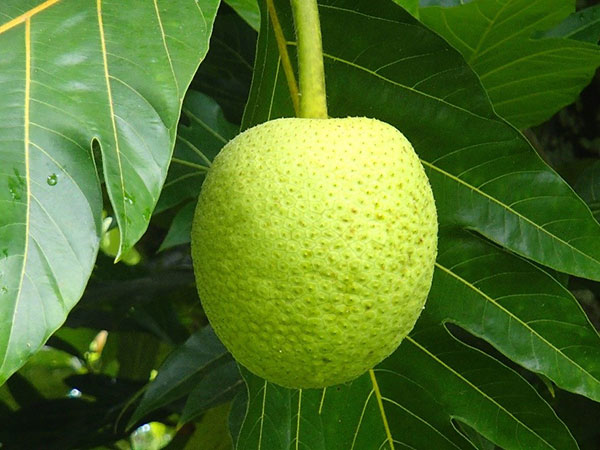The Department of Agriculture and Water Resources is conducting a review of biosecurity import requirements for fresh breadfruit (Artocarpus altilis). The commencement of this review is in response to separate requests for market access for breadfruit from Fiji and Samoa, which have been priorities for these countries for a number of years. Tonga has also expressed an interest in gaining market access for breadfruit, so all three countries will be assessed jointly.
Breadfruit is a member of the Moraceae (mulberry) plant family, and closely related to jackfruit (Artocarpus heterophyllus) and breadnut (Artocarpus camansi). The fruit (Figure 1) are variable in size, shape and surface texture, but are usually round, oval or oblong in shape, and typically weigh around 1–4 kilograms. The skin is tough, and patterned with pentagonal, hexagonal or heptagonal markings. Depending on the cultivar, the fruit may be seedless, or have a few seeds or many seeds, which are edible. The fruit is edible at any stage of development, and can be consumed either as a vegetable or a starch, depending on what stage it is harvested.
Figure 1. Fresh breadfruit near Apia, Samoa

A preliminary pest categorisation for fresh breadfruit from Fiji, Samoa and Tonga has been undertaken to identify potential pests of quarantine concern. The main quarantine pests for Australia are fruit flies (Bactrocera facialis, Bactrocera passiflorae and Bactrocera xanthodes) and mealybugs (Dysmicoccus neobrevipes and Dysmicoccus nesophilus). Two additional mealybug species (Planococcus minor and Pseudococcus cryptus) and four armoured scales (Chrysomphalus dictyospermi, Hemiberlesia cyanophylli, Hemiberlesia palmae and Pseudaulacaspis pentagona) have been identified as regional quarantine pests for Western Australia.
With the exception of Bactrocera facialis, the pests of concern identified in the preliminary assessment have all been considered previously on other commodities. Bactrocera facialis would not be expected to differ significantly from other related pest species of the Bactrocera genus, which have been extensively assessed by the department in other import policies. There are established risk management measures for fruit flies and mealybugs.
The Biosecurity Import Risk Analysis Guidelines 2016 set out the criteria for a regulated Biosecurity Import Risk Analysis (BIRA) allowing the Director of Biosecurity to agree to its commencement. It states in section 3 that a BIRA will be undertaken when:
- relevant risk management measures have not been established, or
- relevant risk management measures for a similar good and disease/ pest combination do exist, but the likelihood and/or consequences of entry, establishment or spread of diseases or pests could differ significantly from those previously assessed.
A risk analysis that does not meet these above criteria may be undertaken as a non-regulated risk analysis. The assessment for fresh breadfruit will therefore be progressed as a non-regulated review of biosecurity import requirements, as most of the pests have been assessed previously and established mitigation measures are available.
Breadfruit in Australia
There is small scale commercial breadfruit production in Australia around Cairns and Darwin. Breadfruit is available at fresh produce markets in some of the major cities when in season between February and March. Production statistics are not available.
Trade between Australia and the Pacific Islands
It is difficult to anticipate potential import volumes of fresh breadfruit from Fiji, Samoa and Tonga. Breadfruit remains a relatively novel commodity in the Australian market, particularly in the southern states, and consumer demand would likely be mostly amongst Pacific Islander and Asian communities in the major cities.
Fiji, Samoa and Tonga currently export fresh breadfruit to New Zealand, which requires a high temperature forced air treatment of consignments prior to export to mitigate the biosecurity risks posed by fruit flies and other arthropods.
Australia is a net exporter of agricultural products to Pacific Island countries. For the 2015-16 financial year, the major Australian agricultural exports to Pacific Island countries included cereals, dairy products and meat. The main agricultural imports into Australia from these countries included animal feed (copra), animal hides, animal and vegetable oils, coffee, fruit, vegetables and spices.
The Department of Agriculture and Water Resources receives funding from the Department of Foreign Affairs and Trade, via the Pacific Horticultural and Agricultural Market Access (PHAMA) program, to implement biosecurity policies that ensure safe agricultural trade from developing Pacific Island countries to Australia. Specifically this involves considering access for new commodities, as well as improving existing trade pathways. Increasing trade opportunities for horticultural produce in the region assists to boost economic development. The review of biosecurity import requirements for fresh breadfruit is being undertaken as a PHAMA priority.
Next steps
The department will undertake a scientific analysis of the risks of importing fresh breadfruit from Fiji, Samoa, and Tonga and consider whether risk mitigation measures are required. The department will liaise with relevant state and territory agriculture authorities to gather stakeholder input to ensure the department has all available scientific information relevant to this analysis.
These findings will be published in a draft report on the department’s website. Stakeholders will be invited to comment on the draft report during a 60 calendar day public consultation period. The department will consider stakeholder comments in the development of the final report.
